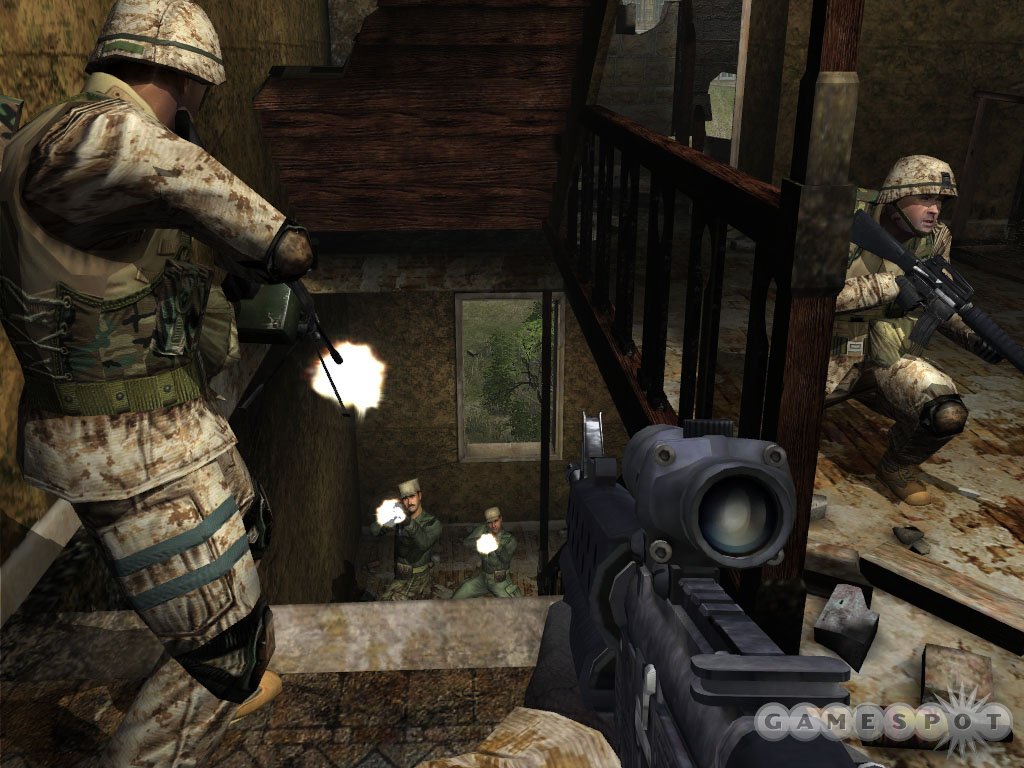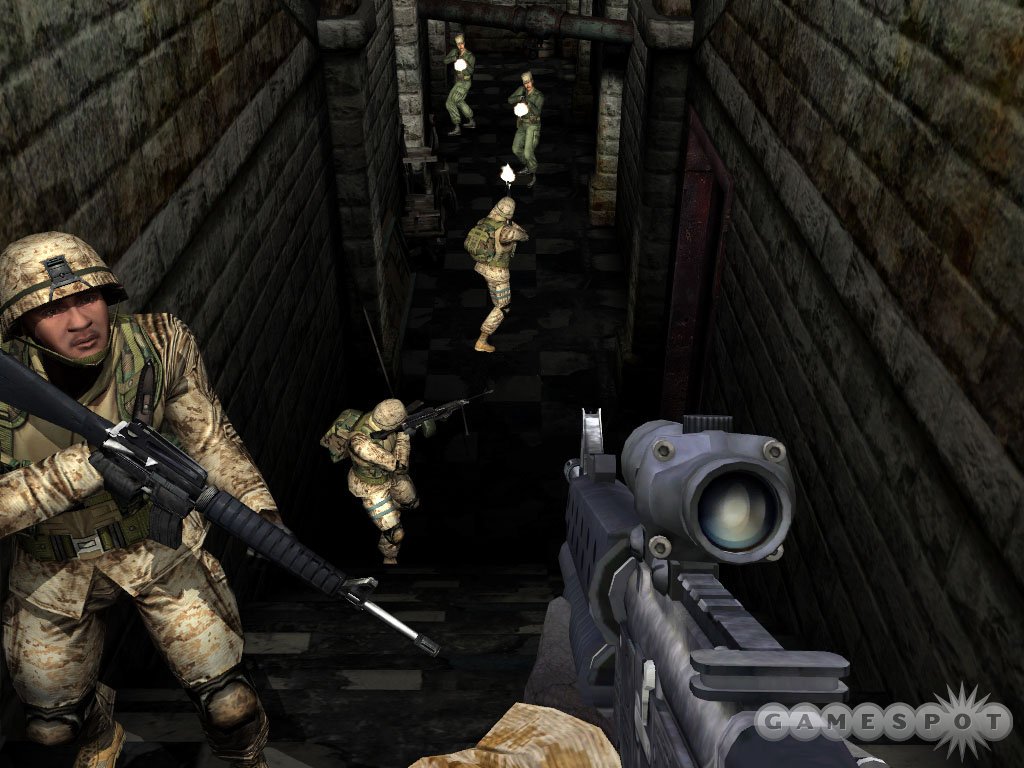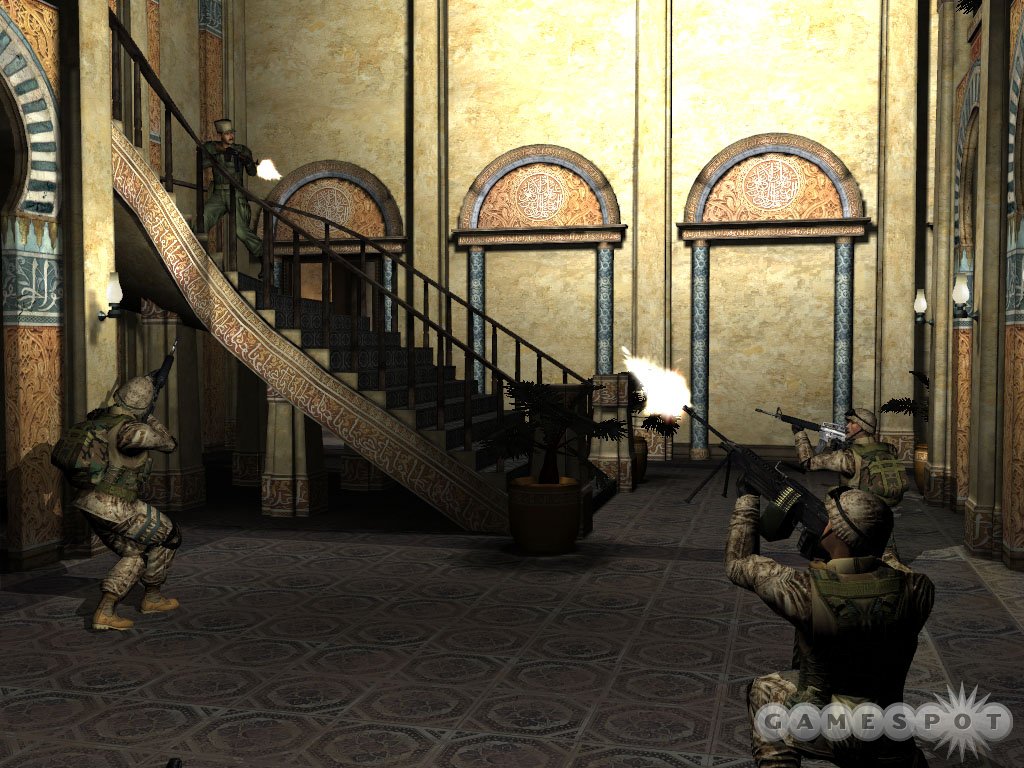Close Combat: First to Fight Hands-On - Single-Player
We dive into a virtual Beirut to experience the single-player action of Close Combat: First to Fight firsthand.
Not content to let the Army have all the action, the United States Marine Corps is working with Global Star and developer Destineer on a first-person shooter of its own, Close Combat: First to Fight. While the Marines intend to use the game as a training aid, civilians will be able to play the game in order to appreciate the dangers and difficulties that Marines face in modern combat. We've been following the development of First to Fight for quite some time now, but recently we had a chance to get our hands on the single-player version of the game and experience the gritty realities and challenges of urban warfare.

Rather than creating a fictional Middle Eastern country, Destineer has set the game in Beirut, Lebanon, in the near future. After factional fighting erupts to once again tear apart that war-torn capital, NATO and the United States dispatch military units to stabilize the country. (Considering recent events in Beirut, this scenario isn't too far-fetched.) Your job, as a Marine fireteam leader, will be to lead your four-man fireteam through the streets, alleyways, and warrens of Beirut to battle insurgents and Syrian Special Forces and hunt for important enemy leaders (each with his own "most wanted" playing card, much like the ones distributed to US forces in Iraq). At the same time, you must avoid harming innocents and civilians, as well as the reporters and cameramen who tend to show up in situations such as this. As Marines never fight alone, you can draw upon the help of other Marine fireteams at times, as well as Marine air and artillery support, but more on this later.
When starting up a campaign, you'll name your Marine and select a difficulty setting. The easier difficulty settings are very forgiving, as each of your Marines will have a health bar and can absorb many hits before falling. You can also use first aid kits to restore health instantly, much like picking up a health pack in a regular first-person shooter. If you want a real challenge, though, you can select the simulation setting, which is what the Marines will use. Simulation is designed to be as realistic as it gets, so the key to surviving is to take things slow and use tactics, such as making sure you order your Marines to cover you while you advance and making sure to peek around corners to locate enemy positions. In contrast to the easier difficulty settings, simulation is pretty much one-shot, one-kill. It's a fairly unforgiving experience for the unprepared and unready, which is probably why you'll want to tackle simulation with other players assisting you in cooperative multiplayer mode. You really need to have each man in a fireteam in sync and working together in order to succeed and survive simulation, which is probably what the Marines intend.

After starting up the game, you'll find yourself in the middle of a virtual Beirut neighborhood surrounded by your men. Immediately you'll receive orders over the radio. These orders will guide you through the level step-by-step. For instance, you'll receive orders to clear out the surrounding streets and alleyways. Once that's accomplished, you may have to clear out a nearby shop. After that, you might have to clear out a school. These tasks each present a tactical challenge for you to overcome and they're usually several ways to approach each of them. For example, if ordered to take down a building, you can try slogging your way through the heavily defended front door, or you may locate a back entrance or a fire escape to bypass the front door. After you accomplish a task, the game saves the checkpoint, so that if you die you can restart at your last checkpoint, rather than starting the level over from scratch. This is particularly helpful, because even at the easier difficulty levels you'll probably die a lot. In addition to the checkpoint system, you can save the game at any point in the PC version, though we found the checkpoints to be fairly well placed.
The Will to Fight
We've covered the context-sensitive command system in the past, but basically if you want to order your fireteam to do something, simply point your rifle at the object in question and hold down the right mouse button to call up the menu system. Thus, you can order them to "take down" a room, which means they'll enter and clear it with extreme prejudice, or to execute a "frag take down," which means they'll toss a grenade in first before clearing the room with extreme prejudice. In addition, you can order them to provide cover or suppression fire in a certain direction. Even when you don't give specific orders to your men, they'll follow you in proper formation, with each man covering an assigned sector so that the fireteam has 360-degree coverage. We battled our way through the first parts of the campaign, securing the neighborhood where NATO forces were operating and then clearing the area around American University. The level design thus far is fairly linear, so there's absolutely no way to get lost in a maze of streets and it's pretty easy to figure out where you need to go next.

First to Fight also uses some of the morale and psychological modeling that was one of the features in the old Close Combat tactical games. Each person in the game has a sophisticated psychological model designed to make them act like real human beings. You will see civilians panic and scatter at the sound of gunfire, whereas insurgents and other hostiles will seek cover and shoot at you. Enemies flee if faced with overwhelming odds, so it's possible to "break" the other side's will to fight, which is an important concept in warfare. This can be done by inflicting heavy casualties on the other side, or by simply cowing your opponents with overwhelming firepower. In addition to the firepower that your team carries, you can call in support from other Marine elements, including snipers, mortars, and helicopter gunships. You'll especially need to call on those forces when you encounter something that your squad can't deal with, such as a technical (a pickup truck with a heavy machine gun mounted in its bed), an armored personnel carrier, or a fortified bunker or building. To do so, simply point your rifle on the target in question and right-click to call up the context-sensitive menu. Then sit back and wait for the cavalry to arrive, whether it is in the form of a mortar strike or a Cobra gunship overhead.
The weapon modeling is designed to be realistic, so it may take you some time to get used to the feel of each weapon. The main targeting reticule does seem a bit large, however, it represents the distribution of where your rounds will hit. Kneel down and the reticule tightens, which is representative of the fact that you have a better firing stance. As team leader, your primary weapon is the M16 assault rifle with an M203 40mm grenade launcher attached to it. Your rifle also has a scope, which you can activate by clicking on your mouse wheel. You can then use the wheel to zoom in and out. The scope is useful when you're trying to pick a guy off at long range. One thing you'll also need to get used to is conserving ammunition. Even though each Marine carries a healthy ammo load, it's easy to burn through clips if you're not careful. We ran out of ammo during one mission, but we found that we could pick up and use enemy weapons if we had to. Another nice touch is the way your teammates will call out their ammo states when firing. For example, they will say "red" when they need to reload and "green" when they have a fresh clip inserted. This way, you can alternate firing to maintain a steady stream of fire on the enemy.

From a graphics perspective, the game is immersive, as you'll battle it out in tight alleyways, plazas, apartment buildings, warehouses, and more. The environments are designed so that there's always plenty of cover to duck behind. The character modeling is quite sharp, and you can appreciate the detail on your Marines' utilities (the Marine Corps term for uniforms). However, at this early stage some of the animation still needs a little work, and the game looks like it needs to be optimized in some places, as the frame rates dropped in certain circumstances. That said, tuning is one of the last things to be done in development, so we'll see how the final version of the game turns out. In terms of audio, the game certainly sounds authentic, from the weapon sounds to the fact that you can hear your opponents speaking in Arabic.
The single-player campaign will be playable in cooperative mode in multiplayer, so obviously having a human partner will change the dynamic of leading AI team members. Still, the single-player campaign is looking good at this point, and the game is coming together well. We can look forward to First to Fight shipping this spring for the PC and Xbox.
Got a news tip or want to contact us directly? Email news@gamespot.com
Join the conversation